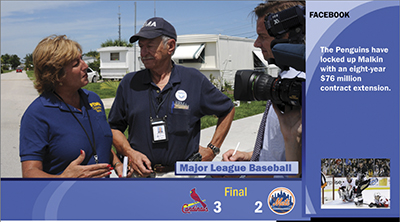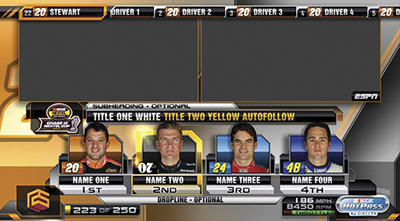The Multiplatform Approach to Sports Graphics

Sports channel using Bannister Lake’s Super Ticker to display the latest scores and social media content.OTTAWA—The need to serve broadcast, Web and mobile video platforms quickly and simply is motivating sports broadcasters like Canada’s 24-hour sports network Sportsnet to seek “input once, serve many” graphics solutions.
“The goal is to put the data in once, and then have that data populate graphics for all of our platforms,” said Dwayne Brown, director of creative technology for Rogers Broadcasting, Sportsnet’s parent company. “We are currently looking at Bannister Lake’s BL Super Ticker ‘news bug’ as a possible answer to this requirement. Ideally, we want to have a graphics creation at the heart of a ‘hub and spoke’ architecture, where data inputted once at the hub goes out to our many broadcast, Web and mobile platforms; serving each with the right aspect ratio, image scaling, and graphic style.”
Based in Cambridge, Ontario, Bannister Lake Software has created a family of graphics products for broadcasters, including BL Scorebug (sports scores), BL Brando (channel branding), and BL Super Ticker (HD news ticker).
“BL Super Ticker is basically a content management console that allows a broadcaster to mix automated data pulled from web sites and other sources with local, manually-input editorial via our BL Flow content manager server,” said Danny Ljubisic, Bannister Lake’s director of business development. “You enter the data once, specifying which templates you want to populate for broadcast and the Web. Because the templates allow you to predefine the look you want to achieve for each medium, the end results are properly scaled for each of them.”
To serve tablets and smartphones directly, the BL Flow server outputs the content using Bannister Lake’s XML/JSON Content Export software, rather than BL Super Ticker. Web graphics created using this software can be viewed on mobile browsers.
CUSTOMIZED LOOK
BlueNet, ChyronHego’s answer to the “input once, serve many” graphics conundrum, uses popular newsroom automation systems such as Dalet or ENPS as its point of entry. The BlueNet workflow solution can accept sports data one time, and then populate it to a range of templates designed for broadcast, the Web, and mobile.
Get the TV Tech Newsletter
The professional video industry's #1 source for news, trends and product and tech information. Sign up below.
“BlueNet works with our graphics products and our CAMIO Cluster asset management server to create, store and serve multiple playout platforms,” said Aldo Campisi, ChyronHego’s vice president of Latin American sales. “Rather than having to enter data for each platform, broadcasters can craft their templates to fit the look, style and layout best suited for broadcast, Web or mobile. They then just enter the data and select which templates to use, and BlueNet does the rest.”
The BlueNet system also integrates with ChyronHego’s Engage second screen and social TV gateway, for sending companion sports information to tablets, smartphones, and sites such as Facebook and Twitter.
Harris Broadcast’s Inscriber Connectus has been specifically designed to support “input once, serve many” platform scenarios. Connectus does this by centralizing all of the user’s Inscriber-created graphics into a single datastore. This datastore is available to everyone on a broadcaster’s access-protected network, regardless of location or function.
After the artist has created the content, sports editorial can select the specific visuals they need, add the data once, and then publish it back to the Connectus server according to Paul Gomes, Harris Broadcast’s product line manager for Inscriber products. “From there, it can be transcoded and sent to multiple platforms automatically, or sent out manually,” he said.
Connectus integrates with newsroom computer systems such as AP ENPS, allowing sports journalists to access the graphics they need from predetermined folders, for quick customization and injection into produced video.

NASCAR uses Vizrt’s Viz Engine to drive data-driven graphics in real time during each of the races.FORMAT, PLATFORM-AGNOSTIC
Orad’s HDVG4 is a next-generation graphics platform that provides quick, efficient multi platform sports graphics production. Using just one input point, the HDVG4 platform “can output content in different formats and different resolutions,” according to Ofir Benovici, vice president of marketing for Orad. “For example, it can output 1080p, 1080i and SD signals from the same box with one user interface automatically respecting the different aspect ratios.” The platform can also serve both 50 Hz and 60 Hz TV systems at the same time.
To serve Web and mobile applications, the HDVG4 platform outputs an IP-formatted graphics stream that can be displayed in a range of different resolutions and the software can optimize content for each kind of distribution channel.
“For example, due to the physical size of the smartphone, less graphics could be displayed on the screen and the graphics that are displayed could be bigger in order to be readable,” Benovici said.
Vizrt’s “create once, use many” solution is based upon its Viz Engine graphics/video rendering platform. “You can play-out 2D and 3D sports graphic templates directly in Viz Engine, input the content and data at a single location using Viz Trio CG or our Newsroom AX, and then use the platform to select your distribution channels and serve both broadcast and Web/ mobile channels,” said David Jorba, Vizrt America’s senior vice president of operations. “Our solution outputs an SDI stream for the first application, and an IP stream or transcoded Web/mobile-friendly files for the second.”
Worth noting; Viz Engine can create graphics suitable for 3DTV right out of the box. As well, the system does not require video cards to be added, to serve IP Streams, the Web and mobile. It also outputs graphics to 4K, making it ready for the next step in broadcast resolution.
James Careless is an award-winning journalist who has written for TV Technology since the 1990s. He has covered HDTV from the days of the six competing HDTV formats that led to the 1993 Grand Alliance, and onwards through ATSC 3.0 and OTT. He also writes for Radio World, along with other publications in aerospace, defense, public safety, streaming media, plus the amusement park industry for something different.

